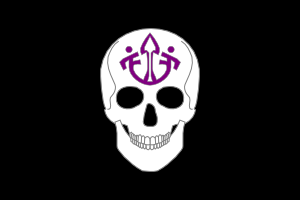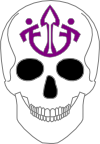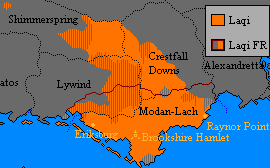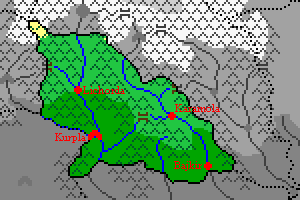Karalakh
Contents
Karalax Xanliki | |

|
|
| Feudal Status: | Khanate |
| Capital: | Kurpla |
| Largest Cities: | Kurpla |
|
| |
| Local Leadership Title: | Khan |
| Local Government: | Necrarchy |
| Current leader: | Doli Khan Karalakhli |
|
| |
| Local language: | Karalakhi, English |
| Local Religion: | Cedrism, Lich Cult |
The Khanate of Karalakh (Karalakhi: Karalax Xanliki) is a county-sized subdivision in Benacia. Part of the Federation of Musica, the Khanate was established in 4831 ASC from the western half of Crestfall Downs and parts of the neighbouring counties of Lywind and Shimmerspring.
Etymology
The term Karalakhi (Karalakhi: Karalaxi, Laqi: Kara-Laҳi; literally "Black Laqi") first appeared in 4830 ASC to describe the Laqi-speaking inhabitants of Crestfall Downs, Lywind and Shimmerspring who pledged allegiance to the lich Marie Dolores von Rossheim-Maltenstein. In local tradition, black denotes the north, so the name may be translated as "Northern Laqi"; others, however, have claimed that the colour refers to the taint of undeath.
History
The Khanate of Karalakh has its origins in the Laqi Secession of 4016 ASC, when forces loyal to Maksym Hadjimehmetov attempted to establish a Laqi Free Republic in Modan-Lach and the Laqi-inhabited districts of the adjoining counties. In an attempt to make their declaration of independence more palatable to the Shirerithian government, the Hadjimehmetov regime effectively conceded control of large areas with clear Laqi-speaking majorities in Crestfall Downs, Lywind and Shimmerspring, resulting in the alienation of these Laqis from their compatriots in the south.
The collapse of the Free Republic and subsequent re-establishment of Shirerithian rule did little to heal the sense of betrayal felt by many northern Laqis, who over the following centuries increasingly began to develop a distinct regional identity. The strength of the north-south divide was clearly demonstrated when the Queen of Brookshire, Anthrazita von Rossheim-Maltenstein, divided the historic county of Crestfall Downs along ethnic lines in 4696 ASC, prompting a spate of ultimately unsuccessful demonstrations by the local Laqis against union with Modan-Lach.
The northern Laqi eventually found a chamption in Queen Anthrazita's daughter, Marie Dolores, who was granted the Marquessate of Modania by her mother in 4796 ASC. That same year, the new Marchioness combined the northern Laqi-majority areas of Crestfall Downs, Lywind and Shimmerspring into a new subdivision under her personal control: the Khanate of Kurpla (Karalakhi: Kurpla Xanliki).
Although the Khanate of Kurpla was dissolved in 4824 ASC, the special bond between the Marchioness and the northern Laqi endured, and in 4830 ASC, the local tribal elders pledged eternal loyalty to her "in life and death". This act, which is generally regarded as marking the beginning of a separate Karalakhi nation, led directly to the establishment of the Khanate of Karalakh the following year.
Politics
Karalakh is officially described as a necrarchy, a form of monarchy in which the ruler (necrarch) is a lich magically bound to the state. In practical terms, the Khanate functions as a semi-constitutional autocracy. The structure of government is defined by a basic law, the Jasa, which gives the necrarch, who has the formal title Khan of Karalakh (Karalakhi: Karalax Xani), supreme executive and legislative authority. The Khan rules by decree, issuing special edicts known as Jarliks. There is no provision for an elected assembly, although the Khan is advised by an assembly of tribal elders called the Great Jirga (Karalakhi: Ix Jirga).
The Khan of Karalakh is Marie Dolores von Rossheim-Maltenstein, who is known locally as Doli Khan Karalakhli.
Geography
Karalakh consists of a pair of large river valleys in the southern foothills of the Crestfall Mountains and has an of area of 619,776 square kilometres.
Economy
Demographics
The living population of Karalakh is estimated at 4 million, of which the overwhelming majority are ethnic Karalakhis. Approximately 42.5% of the Khanate's inhabitants reside in the four main cities of Kurpla, Bajkir, Karamola and Lichorda.
Largest cities
| Rank | Name | Karalakhi | Inhabitants (4847 est.) |
|---|---|---|---|
| 1. | Kurpla | Kurpla | 800,000 |
| 2. | Bajkir | Bajkir | 500,000 |
| 3. | Karamola | Karamola | 250,000 |
| 4. | Lichorda | Ličorda | 150,000 |


